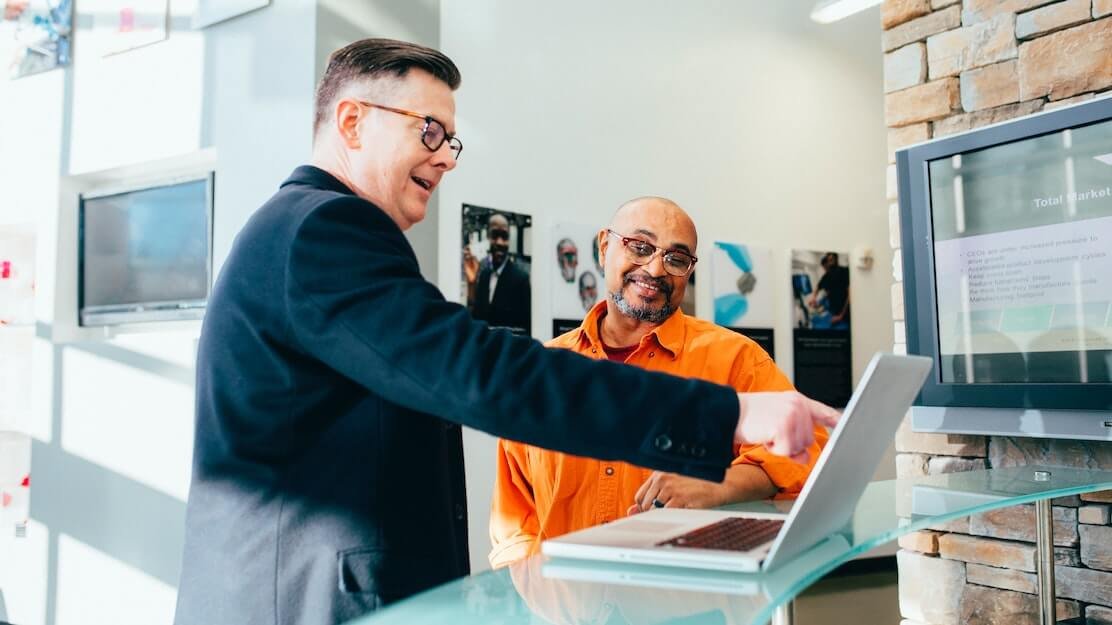It is undoubtedly a concept that we often hear in different countries, but when it comes to human resources and especially during theheadhuntingprocess,the body language of our candidates can reveal valuable information that we will not find in any other way.
In general, communication skills are essential to perform in any job and, in fact,many companies invest in training plansto improve this aspect as part of theskillsof their employees.
However, there is an aspect that often goes unnoticed and that is closely related. We are talking about non-verbal communication, which plays a key and often definitive role during the staffrecruitment process.
What is non-verbal language
Although it is not a concept that we have in mind in 24/7, there is a very common saying that most of the communication occurs in non-verbal form and in fact,there is a general consensus about the influence that what we communicate exerts to others regardless of our words.
In short, verbal language is all the information that we receive and that we transmit to one or more interlocutors, which does not necessarily have to do with what we say.
Have you ever formed an opinion or made a value judgment at first sight? Did someone find you unfriendly or friendly the first time you saw him? These “judgments” that we issue about one or more people after the famous first impression,are formed almost entirely due to non-verbal language.
What is non-verbal language for?
Having adequate knowledge about this subject is a great advantage for recruiters and recruiters of human resources. By observing the non-verbal signs and gestures, that is, what is not said,we will be able to understand a lot about our candidates.
What are their real interests, what things bother them, how do they interact with other people, what is their level of attention or personal safety, etc. All these indicators appear as subtle clues that emerge from the development of a person in a certain social environment, such as thejob interview.
Every day we aresurrounded by thousands of different stimulithat come from peers or from the same environment and in this same sense, we also emit stimuli and communicate with our space even without emitting a single word.
From the micro-gestures on our face, body posture, where and in what way we look at something or someone, through our way of dressing and even punctuality, all this is decoded by others as part of non-verbal language and contributes to form a “mental image” of who and how we are.
Why key non-verbal communication
For better or for worse, we must accept that body language is an integral part of human behavior. More specifically and for practical purposes, it is important to invest time in learning to recognize and correctly interpret the influence of this aspect.
According to the American psychologistAlbert Mehrabian, about 55% of our communication has a non-verbal origin (gestures, facial expressions, body posture) another 38% is for verbal (intonation of words, speech rhythm, voice timbre ) and the remaining 7% is purely verbal. Hence,93% of what we communicate is unconsciously.
This can be done in an individual or group interview, either face-to-face or even remotely via video call or over the phone. Non-explicitly verbal communication surrounds everything and all those with whom we interact on a daily basis and is a fundamental piece that can influence theinternal communicationof a company, itsvaluesand therefore itscorporate culture.
Importance of non-verbal communication in the recruitment process
During thesearch processand after having carried out thecurriculum screening,we will have the possibility to meet our candidates. Although we will know about his professional training and experience, we will know little about his life history, personality and what his true ambitions are.
It is precisely in order to shed light on these aspects that we use the questions we ask applicants.Why do you want to be part of our company? How do you see yourself in five years?They are just some of the most common.
Although they are valid questions to get to know people better,most likely some will not give us 100% honest answers.And it is here where, to be able to trust or not what they respond to us, we must trust what their non-verbal language communicates.
The turnover rate and non-verbal language
Why is non-verbal communication so important during job interviews? Easy: because the main motivation of the recruiters should not only be to find the ideal candidate to fulfill the obligations of a certain role.But it must also ensure that this professional remains in the company.
The first interview is absolutely crucial to know how involved or committed a person is to their future job position, what their level ofmotivation is,as well as how aligned they are with the values of the company and the dynamics that exist there.
This is essential when reducing theturnover rateand making better use of resources since, in the vast majority of cases, thoseinconveniences or risks detected during the initial stage are usually the main factors that make a worker decide to leave. .
Examples of non-verbal communication during job interviews
Having already established the most important concepts, it is time to launch ourselves to explore in detail, those behaviors that in fact make up what we know as non-verbal language and to which you should pay more attention during job interviews.
The first impression
The first few minutes during a job interview are crucial and perhaps even the most important. Just one look is enough to capture the non-verbal signals that come from a candidate and that will help to form an idea of who this person is in front of us.
The way you sit, the speed with which you walk, how you shake our hands (if you do), the way you dress, speak, your eye contact or the lack of it, will help us understand if we are in front of a suitable person to join our company.
But beware, it is also key for the recruiter not to make hasty judgments and to let the interview proceed normally. On the contrary, we will be restricting the opportunities of the worker by falling intorecruitment prejudices.
Body posture and use of space
A person whose posture allows him to occupy the entire seat, who has a position known as “open” (legs uncrossed, arms relaxed), will be a candidate who feels confident in his abilities. Whereas if the posture is “closed” (arms and legs crossed, hunched back), it will generally indicate a great level of personal insecurity.
The handshake
The recruiter should pay attention to the quality of the candidate’s greeting. Ideally, you should be in an upright posture, make direct eye contact, and give your hand a level of firmness that is neither too loose nor too strong. The handshake that transmits, among other things, is the will of the worker and the way in which it is shown to the world.
A weak or weak handshake shows a person lacking in personal conviction. While an excessively strong greeting accounts for a person perhaps too overwhelming over others that he can sometimes impose himself.
Dress and accessories
Regardless of the company’s dress code, in the event that there is a company policy in this regard, the choice of attire for a first interview is crucial.
Naturally, the way of dressing is not everything and this aspect speaks little or nothing about the capacity and abilities of the candidate. What is certain is that a person’s attire reveals clues about their personality and how they prefer to be perceived by other people.
How to use accessories or their quantity, whether or not the person uses perfume and what type of perfume, for example, will reveal valuable aspects of their character. In short, a misaligned person speaks clearly of someone who may not pay much attention to detail.
Eye contact and level of attention
Due to an evolutionary issue, people have the tendency to trust more in those people who, when speaking, manage to maintain direct eye contact.This serves to convey the degree of interest of our interlocutor and his emotions.
However, this may well be faked and indeed many people do. That is why it is important to pay attention that eye contact is accompanied by other gestures that give us the indication that the candidate is, in fact, involved during the interview.
Ideally, an interested person will not only stare at his interlocutor but will show micro-gestures and changes in the area around his eyes as he receives new information. Even your body posture will be slightly tilted forward throughout the process.
Eye contact should feel natural, not forced, not too penetrating, not too scattered.A candidate who passes the interview with his lost or erratic gaze, clearly does not have much interest in what is happening.
The eyes of our candidate will tell us if he is really listening to us or his peers if he is in a group, if he agrees with what he is told or not, if he understands our questions or not and if he answers legitimately or not.
Facial expressions
Few things in life can be as communicative as facial expressions. From the behavioral or psychological, there are a multiplicity of studies that give certain interpretations to what a person’s face reflects.
The key to being able to understand correctly what non-verbal language transmits to us is always to find that those that the person says coincide with their facial expressions,that the verbal and the non-verbal are concordant or coherent.
An example of a matching expression is answering a question in the affirmative while nodding your head. A non-concordant communication will show a person saying yes but with his head pointing sideways.
This can mean two things: at best, some degree of insecurity, shyness, or fear of public speaking. At worst,plain and simple a person who is deliberately lying about or withholding information.
Body language
Body language is also a very powerful source of non-verbal information. Is our candidate reclining in the chair with his legs crossed? How do you cross your legs? Are you fidgeting your hands from left to right or biting your nails? Does it touch your neck or hair incessantly?
Body language reveals so much about how the person in front of us presents himself to the world.Although it is not an unequivocal question, usually nervous body language tells us about an anxious and insecure person. While a relaxed language reveals that we are in front of a serene person who trusts in his own abilities and in the environment.
Although, again, one should not fall into hasty judgments because it is certainly natural for a candidate to show nerves in front of a job interview, we must consider that most likely a person who shows a physical attitude of superiority, over time can reveal himself as a arrogant worker with whom it is difficult to find common ground or flexibility.
However, there are no universal and exhaustive laws on non-verbal body language. Much will depend not only on the context but on what is culturally accepted or not, in a certain place.
Physical contact
This aspect of communication gives us valuable insight into the candidate’s levels of extroversion. A pat on the back or offer a friendly hug, speak of a person who has a great facility to interact and trust others, conveys empathy without the need for words.
On the contrary, a person who does not make any physical contact may be more reserved or shy.In both cases, any extreme type of demonstration or non-contact demonstration is a bad sign.
Tone of voice and other aspects for verbal
The communication for verbal is part of the verbal communication without being directly to the words that we say, but rather, to the way in which we say them and in what way, when and how we say them.
It includes elements such as the volume of the voice, the way in which words are articulated, the speed of speech or even if the interlocutor is interrupted or not.
An optimal verbal language is one in which the tone of voice demonstrates a level of enthusiasm according to the context,to a person who waits his turn to speak and who does so in a concise, clear and understandable way for all.
Non-verbal communication in telework
Nowadays remote selection processes are a super common practice, as well asonboarding in teleworkingand thedigitization of companiesand all their departments and operations.
However, despite not being physically face to face with our candidate, it is also possible to know hisnon-verbal language in job interviews: through written language.
Recruiters usually when communicating via email tend to focus almost exclusively on responses such as “I’m interested in the offer”, “my time availability is …”. But there are definitely many more key aspects to consider that show us the candidate’s personality type.
The use of italics, bold, underlined, capital letters, the size of the font, punctuation and / or spaces that are used show the way in which this person expresses himself.
An email whose content is straight to the point and that shows little attention to the opening and closing greetings, with typos, speaks of a person who does not pay attention to detail. While a well-written email with information organized in a structured way, they demonstrate the opposite.
Communication and non-verbal language are elements that we must take into account during interviews in order to optimize the selection and hiring process of personnel for our company.




